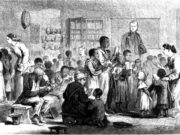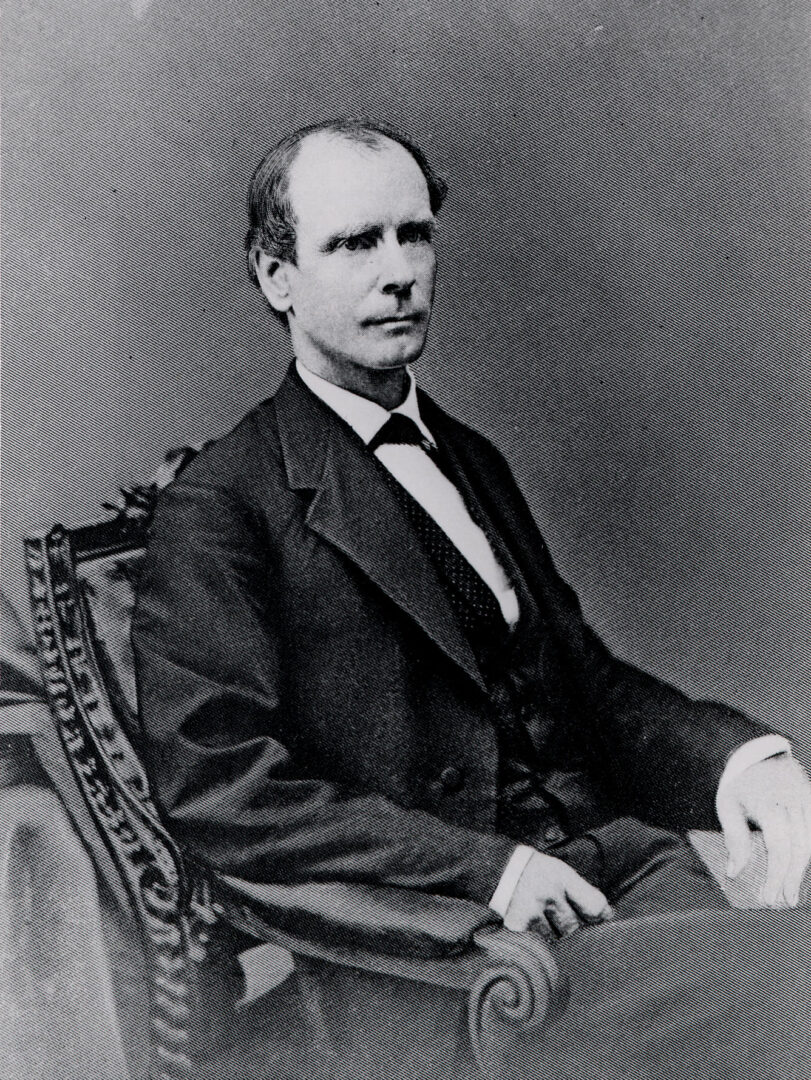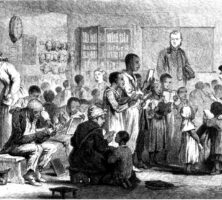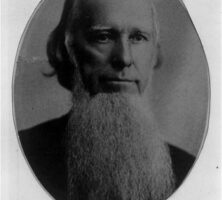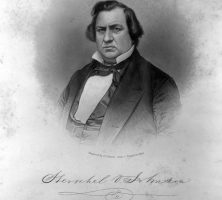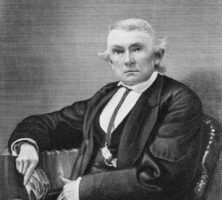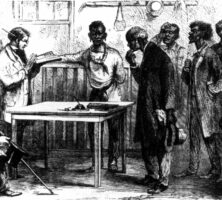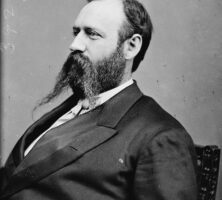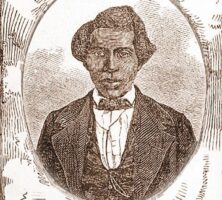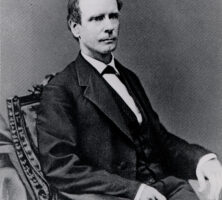As a defeated Confederate state, Georgia underwent Reconstruction from 1865, when the Civil War (1861-65) ended, until 1871, when Republican government and military occupation in the state ended. Though relatively brief, Reconstruction transformed the state politically, socially, and economically.
Aftermath of the Civil War
As the Civil War ended in early May 1865, Georgia’s Confederate governor, Joseph E. Brown, surrendered to Union authorities and was paroled. After attempting to convene the Georgia General Assembly, however, he was arrested and briefly imprisoned in the District of Columbia.
Brown left behind a war-ravaged state, devoid of civil order and fast approaching chaos. Politically rudderless and economically destitute, Georgia faced the future with a white population, which had numbered more than 590,000 in 1860, depleted by some 40,000 Georgians who had been killed or permanently dispersed by the conflict. The state’s Black population, principally more than 460,000 newly freedpeople, confronted a new world with hope and uncertainty.
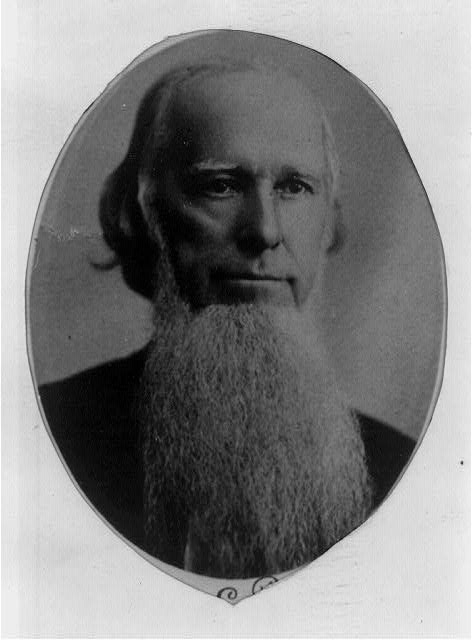
Courtesy of Library of Congress, Prints and Photographs Division
In late June 1865 the Military Department of Georgia was established. For the state’s whites and Blacks, the U.S. Army provided a measure of stability, as well as much-needed food rations in some portions of the state. The soldiers’ numbers during the period from 1865 to 1871 fluctuated greatly, from around 9,000 (June 1865) to more than 15,000 (September 1865), but for most of the period their numbers totaled less than 1,000.
Presidential Reconstruction, 1865-1866
In mid-June 1865 U.S. president Andrew Johnson appointed as provisional governor of Georgia James Johnson, a Columbus Unionist who had “sat out” the war. Following Governor Johnson’s directive (and President Johnson’s Reconstruction plan), elections were held for delegates to a constitutional convention that met in late October 1865 in the capital at Milledgeville. Voters—restricted to white adult males who would take a loyalty oath—numbered only some 50,000 in a state in which 107,000 had cast votes in the prewar presidential election of 1860.
Under the leadership of origina antisecessionist Herschel Johnson, the convention’s delegates framed a state constitution that repealed the Ordinance of Secession, abolished slavery, and repudiated the Confederate debt. Otherwise, the framers made few changes to the constitution of 1861. Major alterations included a prohibition of interracial marriage and a limit on the term of governorship to two two-year terms.

Courtesy of Hargrett Rare Book and Manuscript Library, University of Georgia Libraries.
On November 15, 1865, Georgians elected a new governor, congressmen, and state legislators. The balloting, though not subject to the restrictions of the earlier vote for convention delegates, yielded a dismal turnout of only 38,000 voters. Voters repudiated most Unionist candidates and elected to office many ex-Confederates, though several of these—including the new governor, old-line Whig Charles Jones Jenkins —had originally opposed secession, had sought and secured pardons at war’s end, and had sworn allegiance to the United States.
In early December 1865 the Georgia General Assembly ratified the Thirteenth Amendment to the U.S. Constitution, which ended slavery. The Union’s war aims of unification and emancipation having been met, President Johnson returned the government of Georgia to its elected officials on December 20. The legislature selected the state’s two U.S. senators in January 1866, paving the way for Georgia’s participation in national deliberations for the first time since 1861. The legislators’ choices—Alexander Stephens and Herschel Johnson—created a political firestorm in Washington, D.C., however. Undeniably ex-Confederates (vice president and senator of the Confederacy, respectively), both were also popular, seasoned, and moderate statesmen. The North singled out Stephens as the most flagrant example of the defiance and recalcitrance of Georgia and the South. Neither he nor Johnson nor any of Georgia’s House delegation were allowed to take their seats.
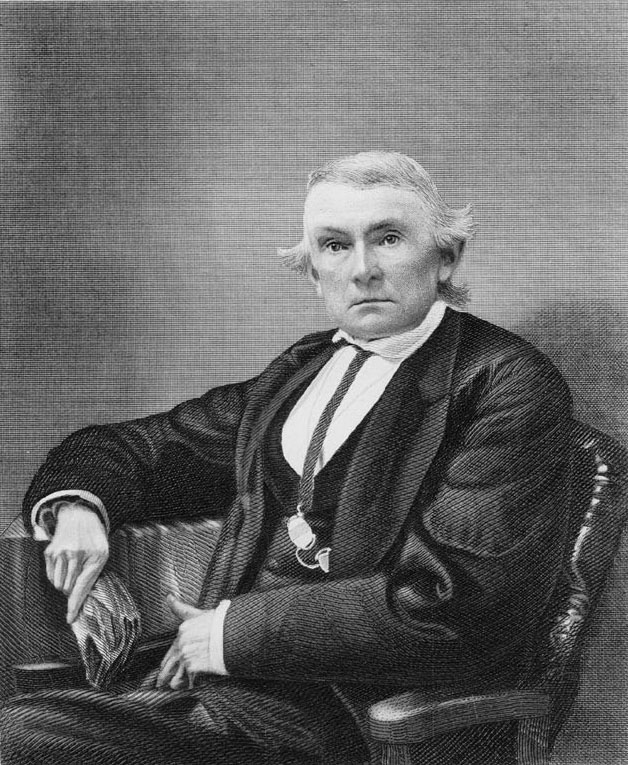
Georgia’s Freed Populace
At the time, politics seemed a luxury few Georgians could afford. Along with its crippled agrarian economy, Reconstruction Georgia faced daunting challenges relating to labor. During harvest time in 1865, many of the emancipated people tested the limits of their freedom. Flocking to towns, where they encountered overcrowding and a shortage of food, large numbers of Black Georgians fell prey to epidemic diseases. Meanwhile, on farms and plantations that had depended on slave labor, harvests were small, with poor planning and miserable weather further diminishing them. Corn and wheat were scarce in late 1865. The state’s traditional money crop, cotton, plummeted in 1865 to around 50,000 bales from a high in 1860 of more than 700,000 bales.
Complicating the situation, rumors suggested that the freedmen would soon be given freeholds and plowing animals. The widely anticipated “forty acres and a mule” for formerly enslaved individuals stemmed from Union general William T. Sherman’s Special Field Order No. 15, issued from Savannah in January 1865. Under that order, federal authorities confiscated “abandoned lands” along the coast and distributed them to freedpeople. This distribution proved temporary, however, as most of the land was soon restored to its original owners. Nonetheless, some Black families were able to buy or lease land from the government.
In the fall of 1865 the Freedmen’s Bureau became active in administering the land program in Georgia and returned much Black labor to the fields, mediating a contract-labor system between white landowners and their Black workers, many of whom they formerly enslaved. Labor would never be the same, however. Field work—once the province of entire Black families—was transformed as the freedwomen withdrew their labor and their children’s labor to the household. Both children and adults began to take advantage of educational opportunities, usually offered by teachers from the North. Often education was associated with the burgeoning number of all-Black churches that also characterized Reconstruction.
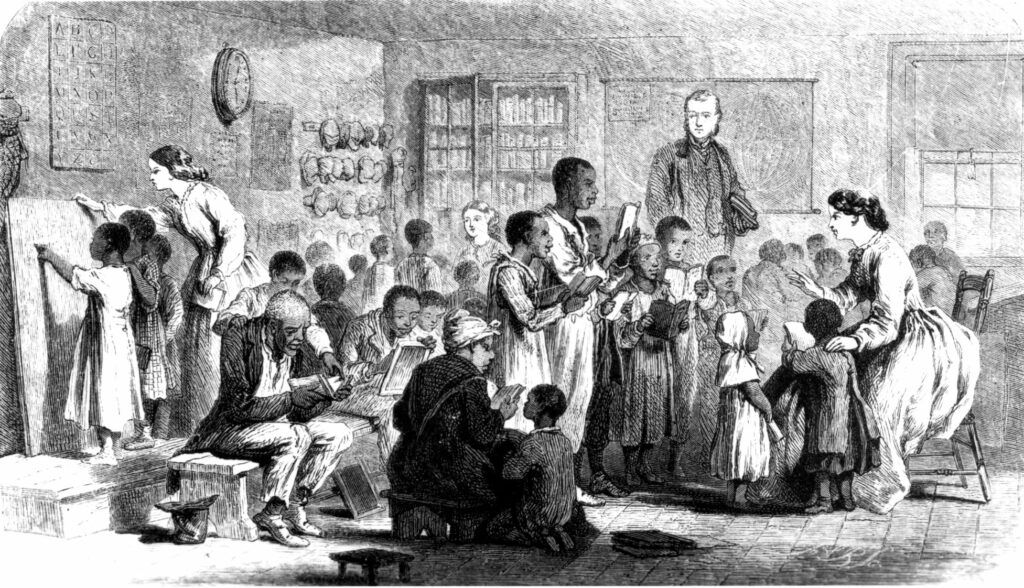
White Georgians looked askance at many of these changes. Many interpreted emancipation in antebellum terms, assuming that the freedpeople would enjoy only the limited freedom of the prewar period’s “free persons of color.” With assumptions of white supremacy still prevalent, there was little talk of the freedpeople as fellow citizens, much less as voters.
Nonetheless, the Georgia General Assembly of 1865-66 treated the Black population as more than a labor source. Among the ex-Confederate states, Georgia stood alone in not creating a harsh Black Code. Though labor problems were partially addressed by controversial but color-blind laws relating to vagrancy, enticement, and apprenticeship, freedpeople were also afforded what has been described as “practical civil equality.” They had access to the courts in being able to make and enforce contracts, to sue and to be sued. They also gained property rights, which meant they could buy, sell, inherit, and lease both land and personal property. They were not to be subjected to any punishment or penalty that did not apply to whites as well. Their marriages and children were legitimized. Nonetheless, important rights were also denied, particularly some that Republicans argued endangered freedpeople’s security: they had no right to serve as jurors or to vote, and they could not testify against whites in court.
The End of Presidential Reconstruction
President Johnson’s Reconstruction program had begun during a lengthy congressional adjournment that extended from March to December 1865. When the Thirty-ninth Congress convened at the end of the year, the Radical Republicans argued that Johnson had exceeded his power in restoring the former Confederate states, all of which but Tennessee they considered unworthy of restoration. Determining to start Reconstruction anew, the Republican majority in Congress created a Joint Committee on Reconstruction that held hearings from January to June 1866 on conditions in the former Confederacy.
The committee reported two portentous pieces of legislation. One—the proposed Fourteenth Amendment to the U.S. Constitution—in its most concise form made formely enslaved people citizens. But it also contained numerous other provisions. These included office-holding disabilities and disenfranchisement for many white southerners, along with incentives for states either to grant Black voting rights or proportionally lose representation in Congress. The other bill, the First Reconstruction Act, called for placing the South under military occupation.
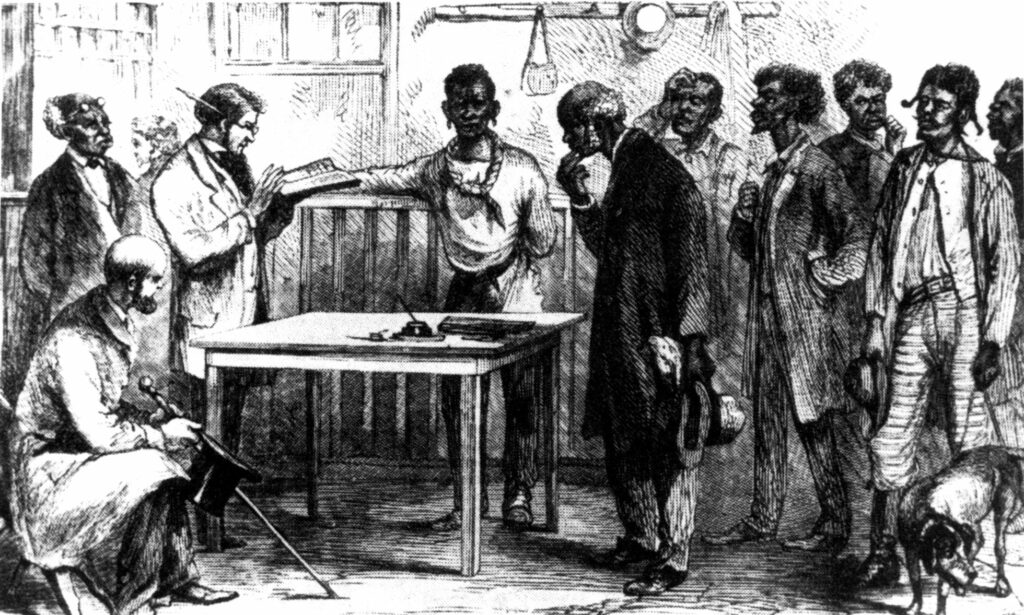
From Harper's Weekly
Since this legislation appeared several months before the off-year elections, President Johnson’s supporters and opponents campaigned vigorously in late summer 1866. In August 1866, Georgia’s white conservatives sent Alexander Stephens, Confederate general John B. Gordon, and other delegates to the National Union Convention in Philadelphia. The convention assailed the Fourteenth Amendment and the Reconstruction Act and championed Johnson’s policies, hoping to turn the Radicals out of Congress in 1866 and return Johnson to office in 1868.
In response, the southern Loyalists’ Convention assembled in Philadelphia in September, with delegates including Georgia Radical George Ashburn of Columbus. The convention supported the Fourteenth Amendment and argued for the continuation of Reconstruction in the South. Both conventions did agree on one issue: neither favored Black suffrage. Johnson’s own campaigning failed disastrously. The Republicans swept the November elections, and the president’s power was permanently broken.
Congressional Reconstruction, 1867-1868
When the Georgia legislature met after the election in November 1866, it almost unanimously rejected the Fourteenth Amendment. The negative report of the joint legislative committee argued that if Georgia was not a state, its legislature had no role in ratifying amendments, and that if Georgia was a state, the amendment had not been placed before it constitutionally. After its Christmas adjournment, this assembly never reconvened, and in March 1867 the First Reconstruction Act passed Congress. Georgia, together with Alabama and Florida, became part of the Third Military District, supervised by General John Pope.
As directed by Congress, General Pope registered Georgia’s eligible white and Black voters, 95,214 and 93,457 respectively. From October 29 through November 2, 1867, an election was held for delegates to another constitutional convention, which would meet from December 1867 into March 1868. General Pope directed the convention to meet at the Atlanta City Hall, which was convenient to his headquarters, since Milledgeville was considered less accessible, and its press was thoroughly anti-Republican. As the Atlanta convention met, a two-day Conservative Convention assembled in Macon to attack Radical policies and to decry Black political participation.
In January 1868 Governor Jenkins, having reestablished state credit and stabilized Georgia’s finances, protested as illegal and unconstitutional General Pope’s $40,000 draft on the state treasury to pay convention expenses. Removed by Pope’s successor, General George G. Meade, Jenkins was replaced by a military governor, General Thomas Ruger. Simultaneous with Ruger’s administration (January-July 1868), the impeachment, trial, and near-conviction of President Andrew Johnson took place in Washington.
By March the 169 convention delegates in Atlanta, including 37 Blacks, had framed a new state constitution that fulfilled the demands of the First Reconstruction Act, including a provision for Black voting. The constitution also called for the establishment of a free public school system, provided for debt relief, gave wives control of their property, increased the governor’s term to four years, and moved the seat of state government from Milledgeville to Atlanta.
A vote on ratification of the constitution and for state officers and U.S. congressmen was held in April, following the sensational murder of Ashburn after he returned home to Columbus. In the gubernatorial race, the Republican candidate, Rufus Bullock, defeated the Democratic candidate John B. Gordon (83,527 to 76,356), with the new constitution approved by a vote of 88,172 to 70,200. In the elections for the General Assembly, 84 Republicans (29 of them Black) fell 3 seats short of a majority of the 172 House seats. In the state senate, however, the Republicans (3 of them Black) took control, with 27 seats to the Democrats’ 17 seats.
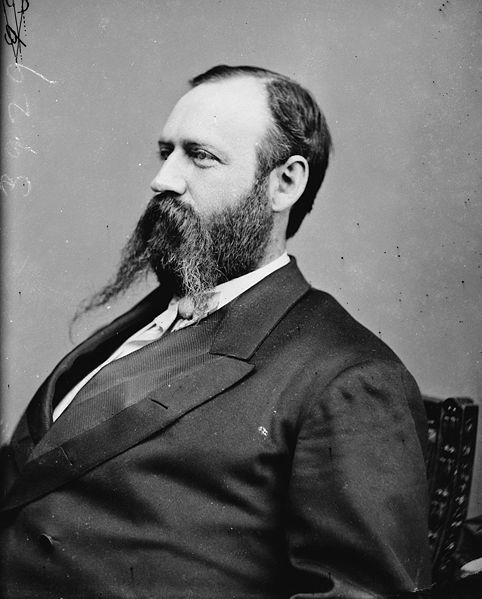
Photograph by Wikimedia
Carpetbaggers and Scalawags
In 1868 the terms carpetbagger and scalawag became preeminent in Georgia politics. Coined by white conservatives, the terms were used to describe the two major groups of white Republicans allied with the far more numerous Black Republicans. Carpetbaggers were northerners who came south after the war to seek their fortune through politics, under a system in which a one-year residence in any southern state brought voting and office-holding rights. Scalawags were southern-born white Republicans or, by a broader definition, any white Republicans who had lived in the South before the war.
By these definitions, Georgia’s Republican government was more scalawag than carpetbagger, particularly since it sent scalawags, rather than carpetbaggers, to Congress. Governor Bullock, though a New York native, was not a carpetbagger, having moved to Augusta in 1859 and having served as a Confederate quartermaster officer. The murdered Ashburn had also been a scalawag. The state’s arch-scalawag, former Democratic governor Joseph E. Brown, became a Republican in 1868 and exercised much power in his new party. Georgia’s major carpetbagger, Union veteran John Emory Bryant of Maine, had come south as a Freedmen’s Bureau official and newspaper publisher.
The term Ku Klux Klan also gained currency in 1868 to describe what the Republicans considered to be the terrorist wing of the Democratic Party: night riders who acted to suppress Republicans of all races and origins. According to most historians, the Klan’s debut in Georgia had been the Ashburn killing in Columbus, and its “Grand Dragon” was none other than Gordon.
Black Republicans, particularly their leaders, served as the principal target of the Klan. Arguably foremost among these targets were Henry McNeal Turner and Tunis Campb
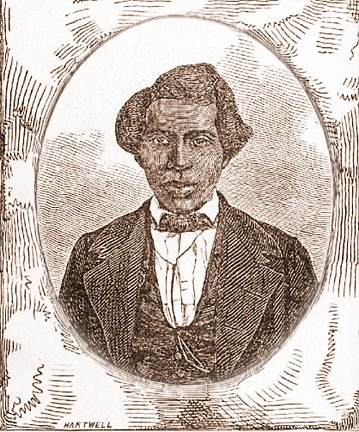
Courtesy of Moorland-Spingarn Research Center, Howard University
That month proved momentous in Georgia Reconstruction: the newly elected General Assembly ratified the Fourteenth Amendment, Republican governor Bullock was inaugurated to a four-year term, and Georgia was readmitted to the Union. But during late July, the Democrats convened in Atlanta to ratify the nomination of the anti-Reconstruction candidacy of Horatio Seymour. At the city’s Bush Arbor Rally, “the largest political mass meeting ever held in Georgia,” prominent Georgia Democrats—including Robert Toombs and Howell Cobb —attacked Congressional Reconstruction in a series of passionate speeches. They reserved special contempt for newly converted Republican Joseph E. Brown, lately a delegate to the Chicago convention that had nominated Union general Ulysses S. Grant for president.
During the April 1868 campaign, Brown had argued that the new constitution did not confer office-holding rights on Blacks. Consequently, in July, the General Assembly’s Democrats and their white Republican allies began a campaign to expel the Black legislators. Although Turner, Campbell, and other Black colleagues in the House and Senate had argued against purging obvious ex-Confederates from the General Assembly, they nonetheless were removed from the body themselves in September 1868. A week later in the south Georgia town of Camilla, in an incident known today as the Camilla Massacre, a confrontation preceding a Black Republican rally ended in violence and death, with some twelve Blacks killed and several whites wounded.
These developments led to calls for Georgia’s return to military rule, which increased when Georgia became one of only two ex-Confederate states to vote against Grant in the presidential election of 1868. In March 1869 Governor Bullock, seeking to prolong Reconstruction, “engineered” the defeat of the Fifteenth Amendment. That same month the U.S. Congress once again barred Georgia’s representatives from their seats. Military rule resumed throughout the state in December 1869.
The Bullock Administration
From the beginning, white conservatives tarred the Bullock regime with charges of fraud, corruption, and general malfeasance. Many of these charges revolved around Bullock’s friend Hannibal I. Kimball, whose Atlanta opera house was converted into the new state capitol building and whose railroad activities drew scrutiny. Other accusations involved Foster Blodgett, Bullock’s political ally and fellow member of the “Augusta Ring,” who was pilloried for alleged plundering as superintendent of the state’s Western and Atlantic Railroad.
The Republican Party in Georgia encountered other difficulties in attempting to create lasting power. The Republicans themselves were split by discord, breaking into pro-administration and anti-Bullock camps, the latter prominently including such leaders as Bryant and Amos T. Akerman, who became U.S. attorney general in 1870. Bullock’s calls for continued military occupation formed a major point of disagreement. Additionally, a permanent working majority, white and Black, never emerged, and Black politicians never felt that they were given a fair share of power or patronage. Nonetheless, Georgia’s lone Black congressman of the era, Jefferson Franklin Long of Macon, served a brief term in 1870-71 and gave the first speech by a Black representative ever presented before Congress. He spoke against removing restrictions on ex-Confederates holding office.
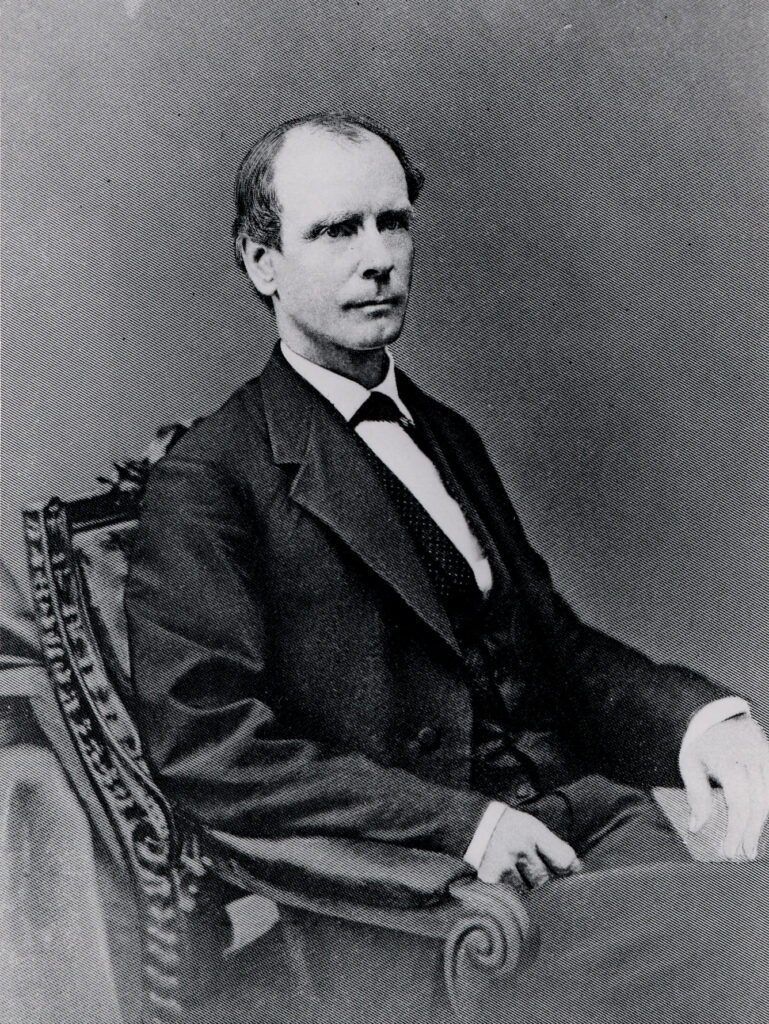
Courtesy of Hargrett Rare Book and Manuscript Library, University of Georgia Libraries.
The End of Congressional Reconstruction, 1869-1871
In June 1869 in White v. Clements, the Supreme Court of Georgia ruled two-to-one that Blacks did indeed have a constitutional right to hold office in Georgia. Ironically, one of the two deciding justices was Chief Justice Joseph E. Brown, appointed by Bullock in July 1868. In January 1870, Alfred H. Terry, the third and final commanding general of the District of Georgia, conducted “Terry’s Purge.” He removed the General Assembly’s ex-Confederates, replaced them with the Republican runners-up, and then reinstated the expelled Black legislators, thus creating a heavy Republican majority in the legislature. In February 1870 the newly constituted legislature ratified the Fifteenth Amendment and chose new senators to send to Washington. The following July, Georgia was again readmitted to the Union.
In December 1870 an election was held for the next General Assembly, to convene in November 1871. The Democrats won commanding majorities in both houses. Bullock’s chances of completing his term now depended on his once again having Georgia remanded to military rule. He failed, and in late October 1871 he fled the state to escape impeachment. In a special election held in December, Democrat and ex-Confederate colonel James M. Smith was elected to complete Bullock’s term. Consequently, as of January 1872 Georgia was fully under the control of the Redeemers, as the state’s resurgent white conservative Democrats came to be known.
The Legacy of Georgia Reconstruction
By 1877, when the final remnants of Reconstruction ended elsewhere in the South as a consequence of the disputed presidential election of 1876 and the removal of federal troops, much had changed in Georgia. Joseph E. Brown, Democrat again and soon-to-be U.S. senator, was increasing the profits of his northwest Georgia coal mines by using the convict lease system, one of the least humane innovations of Reconstruction. Brown’s sometime ally and business partner, Bullock, had recently been tried and acquitted and had embarked on a new Atlanta career that would include the presidency of the Chamber of Commerce. Charges against him and his administration, however, would lead the Democratic Redeemers to draft a new state constitution in 1877 that restricted legislative and gubernatorial power and instituted severe financial retrenchment. Democratic strength in Georgia would increase with time, making the state a reliable component of the Solid South. No Republican would again occupy the Georgia governor’s chair until 2003, when Sonny Perdue took office.
Black Georgia voters, first manipulated, were ultimately disfranchised, beginning in the 1890s. The last Black member of the General Assembly, W. H. Rogers, resigned in 1907 as the final representative of the Reconstruction-era coastal Georgia political machine created by Campbell. Not until 1963, during the civil rights movement (also called “Second Reconstruction” by some scholars), would another Black politician, Leroy Johnson (a Democrat), enter the General Assembly, with a Black Republican, Willie Talton of Warner Robins, not following until 2005.
In large part, for the masses of Georgians, Black and white, the major legacy of Reconstruction would be a sharecropping life. Property taxes, which had previously fallen most heavily on slave owners, now fell on landowners, and during Reconstruction tax rates increased as well. For this and other reasons, a transformation took place. While the majority of Southern whites had owned land during the antebellum period, the majority had become landless sharecroppers by the early 1900s. Though landownership by Georgia’s Black farmers had grown to 13 percent by 1900, most remained sharecroppers. White and Black Georgians awaited another transformation of the economy; it would take World War II (1941-45) to bring it about. Where Black political rights were concerned, another Reconstruction would be necessary.


